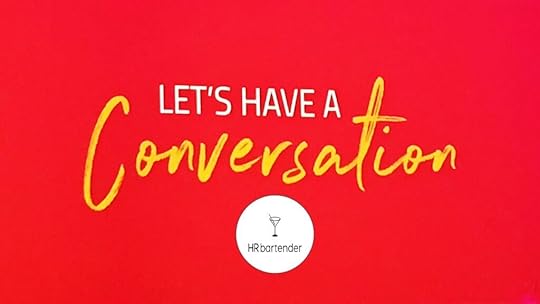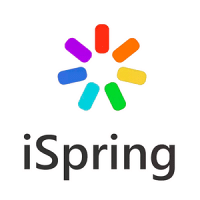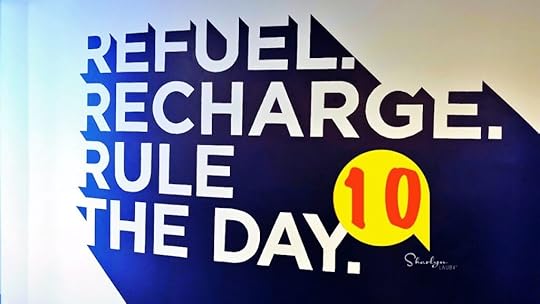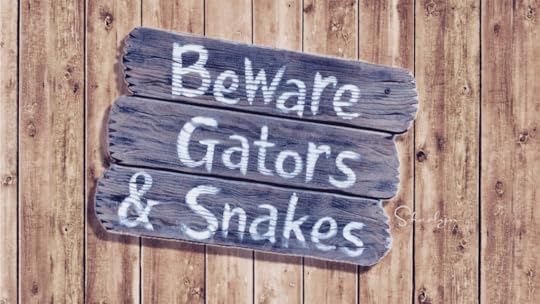Sharlyn J. Lauby's Blog, page 7
June 12, 2025
Bookmark This! The Take Care of Yourself No Stress Edition

Estimated reading time: 4 minutes
If you didn’t see it, April was stress awareness month and May was mental health awareness month. It’s a good reminder to take care of yourself, not just during these months but all year long.
As business professionals, this is an important message. It’s difficult to encourage employees to take care of themselves if we’re not doing it ourselves. I don’t have to tell you that when employees spend their time stressed and worrying, they’re not being productive. This costs organizations money.
The Bureau of Labor Statistics indicates there are approximately 133.4 million full-time employees earning an average of $28 per hour. This means the cost of employee worry is in the billions. Here are some resources to help organizations make wellbeing a priority.
Employee Wellbeing Should Be Part of Your Organization’s Employment Brand
Many companies are looking for ways to stand out as an employer. Showing candidates and employees that the organization values wellbeing is a way to do just that. The keyword here is “showing”. It’s time for organizations to let candidates and employees know they have programs in place for wellbeing. Don’t hesitate to make the wellbeing message part of the organization’s recruitment marketing strategy. It could be very helpful in attracting, engaging, and retaining talent.
Worrying Is a Symptom of Employee Stress
Employee stress is a real workplace issue. According to a study from Colonial Life, more than 20 percent of workers spend more than five hours on the clock each week worrying. An additional 50 percent of employees said they lose between one and five hours of work to worry each week.
Being a Nice Person Could Be the Source of Your Stress
Our best career advice for others is often to be a servant leader, pay it forward, be nice, help others, etc. However, if every time someone asked we said “yes”, we could be placing ourselves in a position where we’re sacrificing our own wellbeing and goals for others. And creating stress and burnout.
Become a Better Mental Health Ally Through Training
I understand how it could be a challenge to help someone who is at risk or looking for support, especially if you’ve never been in the situation before. Maybe not knowing the right thing to say or do. Or where to direct the person for care. That’s why a program like the Workplace Mental Health Ally Certificate could be valuable. Part of supporting mental health is being able to communicate. We need to be able to listen and possibly guide an employee to get the resources they need – maybe for themselves or for a family member.
The Next Employee Challenge: Loneliness in the Workplace
Loneliness is not the same as being alone. Being alone is … being by yourself. Often, we talk about loneliness in terms of older people. In the New York Times article, “The Surprising Effects of Loneliness on Health”, the author shares that loneliness can raise stress levels, increasing the risk of heart disease, diabetes, and dementia. When people are lonely, it has an impact on their work. Totally makes sense. The solution? Create more connectedness at work. Frankly, that’s easier said than done.
Company Wellbeing Programs Must Be Employee Centric
The American Psychological Association reports that more than half of adults cite work as a source of stress. There’s so much conversation about the presence or absence of work / life balance and the importance of employees having a sense of wellbeing. Addressing employee wellbeing isn’t some feel good mantra. It’s a workplace imperative.
I hope that you find these articles to be helpful. I wish I could say that there’s some way to just eliminate stress from our personal and professional lives, but I don’t know that exists. As business leaders, we can put wellbeing programs in place and encourage our employees to use them.
Image compiled by Sharlyn Lauby after exploring the streets of San Francisco, CA
The post Bookmark This! The Take Care of Yourself No Stress Edition appeared first on hr bartender.
June 10, 2025
Voluntary Benefits Can Offer Employees Additional Options

Estimated reading time: 5 minutes
Employee benefits play a huge role in attracting, engaging, and retaining talent. According to an article in Forbes, 60% of employees say that benefits are extremely or very important when considering whether to stay with their current employer.
Selecting benefits can be difficult. What I mean by that is there are some benefits almost everyone wants (example: healthcare) but other benefits might be desired by a smaller percentage of the workforce – like pet insurance. It doesn’t mean that it’s not important but not everyone has a pet.
If an organization wants to offer benefits that a lot of employees want … but maybe not everyone wants … voluntary benefits could be an option.
To help us understand more about voluntary benefits, I spoke with Heather Garbers, CVBS, senior vice president of voluntary benefits and technology for HUB International. Heather is responsible for driving voluntary benefits sales and strategy. She is also responsible for partnering with clients to build optimal enrollment and communications solutions that enhance employee understanding of and engagement in voluntary plan options.
Heather, thanks for being here. Let’s start with a definition. What are voluntary benefits?
[Garbers] Voluntary benefits is a broad term that refers to non-core insurance offerings such as life, disability, critical illness, accident insurance, hospital indemnity, legal services, identity theft protection, pet, student loan services, early wage access, and more.
While some of these plans may be employer-paid, they are traditionally voluntary/employee-paid plans that allow individuals to tailor their benefits to their unique needs.
What’s the advantage – to organizations and individuals – of offering voluntary benefits?
[Garbers] These offerings are gaining popularity as employees increasingly view their employers as trusted sources for comprehensive benefits that support their financial, mental, and physical well-being. For employees, purchasing these benefits through the workplace often provides access to group rates, group underwriting, and plan designs or coverage options not available individually.

For employers, voluntary benefits provide a cost neutral and valuable way to stand out in a competitive job market by addressing the diverse needs, goals, and life stages of today’s workforce – while showing they care about their wellbeing. Maximizing return-on-investment (ROI) requires a consultative, educational approach, as many employees remain unfamiliar with these offerings. Clear, accessible communication is essential to drive awareness and enrollment.
In your definition, you listed several types of voluntary benefits. Can you elaborate on some of the more popular ones?
[Garbers] Pet insurance is currently the most frequently requested voluntary benefit among employees. However, many of our clients are now choosing to integrate accident, critical illness, and hospital indemnity coverage into their core benefits strategy. These benefits help employees manage unexpected out-of-pocket medical costs and ensure access to essential care.
Interest is also growing in non-traditional benefits like legal services and identity theft protection, which offer multi-generational appeal, cost-savings, and services that enhance overall employee well-being.
If organizations are curious about offering voluntary benefits, how do they find out what employees want?
[Garbers] Your benefits consultant should have access to specialists that can evaluate your current benefits offerings, employee demographics, and benchmarking data, to identify voluntary benefits options that complement your benefits strategy and address any gaps in coverage. They can also help design employee surveys or implement focus groups to help better understand which benefits your employees value most.
Last question, once organizations do their internal research and know what types of voluntary benefits they’d like to offer, how can an insurance broker help with implementation?
[Garbers} A benefits consultant can work with you as a trusted partner throughout implementation—managing the quoting and analysis, providing recommendations that align with your technology and administrative needs, and ensuring the best employee experience. They can also support you with education and enrollment strategies, easing the load of communicating new benefit options to your employees.

My thanks to Heather and the HUB International team for sharing their knowledge with us. If you want to learn more about voluntary benefits, check out this article on “4 Steps to Using Benefits Data Smarter to Create Voluntary Benefits”. It can help create a starting point to explore what employees want.
There’s a lot of conversation in today’s business world about working smarter and being more productive. This often comes with asking employees to “do more with less”. And employees are willing to work hard. But they also expect to have an employee value proposition that aligns with their employee experience. Employee benefits are a part of that complete package.
The post Voluntary Benefits Can Offer Employees Additional Options appeared first on hr bartender.
June 8, 2025
Defining HR Value – Ask #HR Bartender

Estimated reading time: 4 minutes
I received this note from an HR Bartender reader. While creating value is always important, I think this is a very timely conversation given everything going on in today’s business world.
Sharlyn, this might seem like a curveball, but how do you define HR’s true value for the business? We hear all sorts of theories, but what’s the real, tangible impact? Can we truly quantify what HR contributes to the bottom line?
Part of measuring HR’s value comes from understanding what HR does and what they’re responsible for. For example, I wrote an article recently mentioning that employee retention isn’t exclusively an HR metric. Other people influence employee retention outcomes. So, if the organization is thinking that turnover is owned by HR and holding them accountable for it, that could have an impact on HR’s value. And not necessarily in a good way because … well, we don’t have control over it.
So, let’s start defining HR’s value by describing HR. I think human resources has three parts:
HR Knowledge: This is what we think of as the functions of HR (i.e., employment legislation, talent acquisition, engagement, total rewards, learning, labor relations, etc.). Do we have to know them all? No. Do we need to know them in detail? No. We do need to understand what HR encompasses and be self-aware about our level of knowledge. That way, we can call on other resources when we need them. For instance, we might work in a non-union environment but now are faced with an organizing situation. We’ll want to contact experts that can assist.HR Behaviors: I consider this to be the competencies that we need to be a good leader and manager in the organization. Skills like communication, analytical skills, decision making, problem solving, etc. These are all necessary to be a good human resources professional. In fact, these skills are also necessary to be a good employee. In this area, we’re being held accountable to the same standard as everyone else. And that’s okay … we should be. Organizational Connection: The final component gets to what I think the reader is referring to when it comes to HR’s value. I wish I had a definitive answer. I think that HR’s value comes from what the organization values and making that connection between what HR does and organizational results. For example, let’s say we’re a not-for-profit organization and we measure results by the number of people we provide services to. Then HR’s value comes in making the connection between what we do and the number of people the organization provides services to.If you’re unsure about what the organization values, find a way to ask the question. Don’t assume that every organization values the profit line and only the profit line. That’s not to say profit doesn’t matter. But organizations often have multiple outcomes they’re trying to achieve, and that information should be known. This provides a starting place to make the connection between HR’s role and organizational outcomes.
It’s also possible that the organization is going through a transition right now and redefining what value means to them. That can have consequences for multiple departments, including HR. Maybe HR always thought their value was in ABC and now there’s a new CEO, who feels their value should be in XYZ.
And if you already know what the organization values, but you’re trying to figure out how to quantify it, check out the book “How to Measure Human Resources Management” by Jac Fitz-enz. This book goes into great detail about how to measure HR activities. Personally, I think every HR office should have a copy for reference.
Human resources departments have a wonderful opportunity to show their value to the business. Not only through the use of employee stories (qualitative) but using analytics (quantitative). The best way to establish the value connection starts with understanding the organization’s value.
Image captured by Sharlyn Lauby while exploring the streets of Nashville, TN
The post Defining HR Value – Ask #HR Bartender appeared first on hr bartender.
June 5, 2025
5 Steps for Managing a Project

Estimated reading time: 4 minutes
A project is defined as “a piece of planned work or an activity that is finished over a period of time and intended to achieve a particular purpose”. We have projects in our personal and professional lives. Work related projects might be things that we do frequently like recruiting a new software engineer. It’s a planned activity that happens over time and is intended to achieve a particular purpose – hire the best software engineer. Projects could also be work that happens less frequently like a software implementation.
While sometimes organizations engage with outside consultants to manage projects, often they look to their management team. Especially when budgets are tight. The reason I wanted to talk about projects today is because managers should be given the education and tools to manage these tasks well. At some point, they’re going to get asked to be on project teams and possibly lead the team.
Here are five key steps to managing a project. This could be a good time to discuss within the organization how managers learn these skills. Some organizations might have dedicated project management classes and that’s great. But other organizations might have training programs that already cover some of these topics. My point being, use what you have … just make sure that managers are up for the task.
STEP ONE: Defining the project. It’s possible that the initial thought about the task will come from senior management. And that’s fine. But senior management needs to communicate the goal of the project. What is the outcome expected from the project team? It’s possible that before the activity can begin, there might be discussions to clarify expectations. For instance, let’s say the organization decides to implement artificial intelligence (AI). What kind of AI tools might require additional conversations.
STEP TWO: Planning costs and timetable. Once a project is defined, then resources must be allocated and a timeline for the task has to be created. It’s possible that in defining the project some rough guidelines have been discussed but now is the time for details. I remember years ago working on a project to launch a training program. The most important thing was for the program to launch on time. The project team had almost a blank check to get the work done. That didn’t mean we were reckless with resources, but rather that we understood the top priority. Project teams will be evaluated on their ability to deliver results, on time, and within budget.
STEP THREE: Establishing the team. A project manager should be assigned as well as team members to work on the task. Using a RACI or MOCHA responsibility chart can help identify who will do what on the team. A couple of key activities that can help the team start off well is having an official launch meeting, attended by the sponsor and/or champion for the activity. And conducting a team building session, especially if team members do not know each other well.
STEP FOUR: Implementing the project. This is when the work gets done. Obviously, the work will be driven by the goals of the task. But the first three steps are a great way to set the team up for success. The launch meeting allows the team to understand the scope of the project. They have a budget and timetable to work with. Team building provides the group with tools to communicate well and work through challenges.
STEP FIVE: Wrap-up. Once the project is completed, the team should be allowed to properly debrief. What went well? What could we do differently next time? They can review their goals, budget, and timetable to see how the activity progressed and end results. Also, give the team time to celebrate their successes. The project manager might be asked to share a final wrap-up with senior management.
Working on a project is hard. Often, we’re asked to work on projects in addition to everything else we have going on. But projects can be great opportunities to learn new skills and build relationships around the organization. By providing the tools to be successful, the project is implemented well, and employees look forward to the next experience.
Image captured by Sharlyn Lauby at the Museum of Discovery and Science in Fort Lauderdale, FL
The post 5 Steps for Managing a Project appeared first on hr bartender.
June 3, 2025
5 Real Benefits of Using a Learning Management System

Estimated reading time: 7 minutes
(Editor’s Note: Today’s article is brought to you by our friends at iSpring Solutions , a leading provider of eLearning software. iSpring was recently named a gold winner in the customer education achievement of the year category at the Globee Awards. Congrats to them and enjoy the article!)
Regardless of what’s going on in the business world, employees need training. Some of that training is compliance related, like anti-harassment training. Companies might also have what they call ‘mandatory’ training. For instance, before an employee can use a certain piece of equipment, they must attend a training session on how to safely use the equipment. And organizations have training that’s designed to improve knowledge and skills, like problem-solving and communication skills.
Organizations that make an investment in learning see positive results. Research by the Association for Talent Development (ATD) indicates that companies with robust training programs can see up to a 218% higher income per employee than those without. Couple this statistic with one from LinkedIn citing that the number one employee retention strategy is providing learning opportunities to employees. Bottom-line, organizations with training strategies outperform.
But I also know from experience that designing and delivering training programs can be overwhelming. That’s why organizations might want to consider using a learning management system (LMS). A learning management system (LMS) is a technology solution that delivers and manages online training programs. If you’re not familiar with what an LMS can do, here are five benefits of using this technology along with some real-world examples.
Pricing and ScalabilityAutomation, Consistency, and ComplianceFlexibilityMonitoring and ReportingEmployee EngagementTo me, the greatest benefit is how all of these interrelate to deliver an efficient and effective learning system.
Benefit #1 – Pricing and Scalability. Let’s put the money conversation out there first. An LMS can help the organization reduce training expenses. First, because instructors and / or participants don’t have to travel. Second, pricing models for LMS solutions are often quoted in terms of active users. This allows the organization to budget based on employee headcount.
This type of pricing structure allows the organization to plan. Let’s say a retail company is planning to open a new store later this year. In their budget for the new location, they can include the cost of adding those new employees to the LMS.
Benefit #2 – Automation, Consistency, and Compliance. An LMS is like many other technology solutions in that it has automation capabilities. Participants can easily enroll in a course and after attending the session, participants can automatically receive certificates of completion.
Automation brings the advantage of consistency, which is especially important when the organization is delivering compliance topics. Organizations can develop a learning session and deliver it multiple times knowing participants are getting the same information.
As much as we might not want to say it, when you have a training program being delivered by multiple instructors, it is possible that participants are getting different information based on who the instructor is. Frankly, even the same instructor might not deliver the program the same way each time. And depending on the topic, inconsistency could become an issue. It’s one thing for one instructor to tell a funny story that another instructor doesn’t tell. It’s another thing for one instructor to mention a safety feature and another instructor to leave it out.
Here’s a real-life example, SIMAC (Svendborg International Maritime Academy) is a recognized educational partner in the maritime business industry. Their training programs are required to adhere to International Maritime Organization (IMO) standards. One of their initial goals in implementing an LMS was to create a user experience that was focused on their compliance related content versus administration. As such, they wanted participants to easily register for sessions.
As they spent more time using their LMS, they realized that instructors were able to record sessions in advance, providing consistency in delivery. Not only did this benefit their training from a compliance standpoint, but it allowed SIMAC to reduce travel expenses and decrease their overall carbon footprint.
Benefit #3 – Flexibility. As mentioned in the SIMAC case study, sometimes a challenge with training can be scheduling participants to attend. Because an LMS is a technology solution, employees can attend training from anywhere and at any time. This is great for organizations with multiple locations or companies that have hybrid / remote workforces. It’s also perfect for organizations that have 24/7/365 operations. Let employees train when it works best for them. Not just when it works best for the training department.
Reig Jofre is a pharmaceutical company based in Spain with operations in more than 70 countries. They’ve been in business since 1929 and the scope of their work is focused in three areas: pharmaceutical technologies, dermatology and osteoarticular care, and consumer healthcare. Because they have a presence in many locations, Reig Jofre hires a lot of remote and field workers. Of course, they want all their employees to receive the same high-quality training. That’s why they decided to implement an LMS. Employees can schedule training when it works for them. The organization can monitor results to ensure that employees are getting the training they need and satisfactorily completing required programs.
One other feature of LMS flexibility is that content can be adapted to accommodate individuals with disabilities. This ensures that everyone in the organization has access to quality learning opportunities.
Benefit #4 – Monitoring and Reporting. Speaking of monitoring results, an LMS allows the organization to track both organizational and individual progress.
From an organizational standpoint, the LMS can report on how many people have attended a specific training program. Let’s say the company has a new procedure for completing expense reports and they are asking everyone to attend a short session on the new procedure. At any given time, HR can view how many people have attended the program.
Another example might be related to how employees are progressing on training in a multistep process. Jitasa is the largest accounting and bookkeeping service provider in the U.S. working exclusively with nonprofits. Because they’re an accounting firm, it was important to ensure that the skills of the accounting team are verified.
By using a checklist feature within an LMS, Jitasa was able to assess, certify, and track employee skills. After five months of employment, Jitasa employees take a 90-question quiz to confirm their knowledge and skills. The monitoring and reporting feature in an LMS allows the company to not only see how many employees have taken the quiz and their score, but they can use that information for future updates to the learning experience.
Benefit #5 – Employee Engagement. All the features we’ve discussed so far: affordability, consistency, flexibility, and monitoring – lead us to the final benefit. Employee engagement.
Employees want training. According to LinkedIn’s Workplace Learning report, 84% of employees say that learning adds purpose to their work. The good news is people are becoming more accustomed to online learning experiences. In a study conducted by the National Center for Education Statistics (NCES), most employees prefer self-paced, online learning because they don’t have to worry about commuting to a class.

And, if organizations are concerned about online learning not being interactive enough, keep in mind that today’s online learning sessions don’t have to be just an employee and a computer. Today’s learning can be social, and instructional designers can create activities that allow for interaction among participants.
Learning Management Systems Help Deliver Quality Training
I know organizations are focused on being more efficient. They always are. One of the keys to being more efficient is having a well-trained workforce. Using an LMS allows organizations to consistently deliver quality training in an efficient way.
If you want to learn more about selecting a learning management system solution, check out iSpring’s article on “The Top 5 HR LMS: Choosing the Best Solution”. While you’re at it, iSpring has a lot of great resources in their knowledge hub you might find interesting as well., including this guide on “The Top HR and L&D Challenges eLearning Can Solve”.
I’ve always worked in industries where employees were a key differentiator in the customer service. That means making sure they received the right training at the right time. It can set your organization apart. It also sends the message to employees that the organization wants to see them succeed.
The post 5 Real Benefits of Using a Learning Management System appeared first on hr bartender.
June 1, 2025
10 Work Skills Every Recruiter Wants to See Today

Estimated reading time: 4 minutes
It should be no surprise that the business world is constantly changing, which means work related skills are changing as well. I thought it might be productive to share a list of skills that recruiters are looking for … regardless of your job title. This is a list of skills that recruiters expect everyone to possess – both managers and employees.
Now, some people might say this list is basic – and it is. That’s exactly the point. Recruiters are often frustrated that candidates (internal and external) don’t have these skills.
Customer Service. Whether you work in the goods or services sector, understanding the value of customers is essential. This includes the proper way to greet customers, remembering their name, and answering general customer inquiries. Organizational Skills. I’m going to lump time management into this category as well. Everyone has multiple things going on in their lives. We all have to find a method for prioritizing our tasks, maintaining a list, putting it on a calendar, etc.. Forgetting stuff and missing due dates isn’t an option.Written and Verbal Communication. When it comes to writing, employees do need to know basic grammar and sentence construction. And when you have doubts, know how to look rules up. Artificial intelligence (AI) is becoming a great tool for this. In verbal communications, managers and employees should know how to offer constructive feedback and hold an effective two-way conversation. This includes being able to listen with empathy. Technology. Speaking of artificial intelligence, organizations today expect employees to have some technology skills. This is related to both hardware and software. There’s a level of expectation that employees know how to use word processing software, can participate in a video conference, are able to take computer-based training, and can effectively prompt a simple AI query. Data, Metrics, and Analytics. The business world is very numbers driven. Employees need to have math skills. We’re not talking algebra or trigonometry. Managers and employees should know basic arithmetic and statistics so when they are presented with data, they know how to read it and use it to solve problems. Problem Solving. I’ve talked in the past about the value of problem-solving training. At times, managers and employees are expected to do critical thinking, reasoning, and independent problem solving. If you don’t already have one, I recommend finding a problem-solving model that works for you. Research and Information Gathering. This ties into the previous points about data and problem solving. Whether it’s searching the internet to troubleshoot a problem or collecting accurate data to calm an unhappy customer, sometimes we have to figure some stuff out on our own. Employees should be curious and willing to ask questions. They also need to be open to letting others know when they don’t know something. Teamwork. No matter who we are and what job we have, it’s impossible to do it alone. Employees must be able to work with others. Remote and hybrid workers are not exempt from this. This means communicating effectively, empathizing with others, and learning from them. This also includes being able to resolve conflicts within a team. Learning. Being a lifelong learner is not a fancy workplace slogan. It’s a reality. Today’s workplaces require us to continuously learn new skills. Employees should be open to new learning experiences, aware of how they prefer to learn, and prepared to articulate their learning style to management.Stress management. It’s very difficult – almost impossible – to tell others how to manage their stressors. What we can do is work toward understanding our own stressors, how to best manage them, and recognize how it impacts others.So, there’s the list. You might be saying to yourself, “Great! Now what do I do with it?”.
Think about using this list as a career development tool. For each of these skills, rate yourself on a scale of 1-10 (1=very little knowledge to 10=consider yourself to be an expert). Any area you’ve rated yourself less than a 5 might be worth some focus. You can develop skills by doing three things.
Reading – books, blogs, magazines, or online contentListening – podcasts, webinars, or attending conferencesDoing – volunteering for a task or practicing a skill during trainingThis could be an activity you’d like to do when setting goals. Maybe chart your progress over time. You don’t have to show anyone. This is just for you.
Over time, this list might change. Or there will be a new aspect to a skill. For example, I could see technology being a skill for a very long time but the types of hardware and software that employees need to know may change. The point is to regularly take inventory of your skills and set goals to keep your skills relevant.
Image captured by Sharlyn Lauby while exploring the streets of Salt Lake City, UT
The post 10 Work Skills Every Recruiter Wants to See Today appeared first on hr bartender.
May 29, 2025
Productivity Series [Part 5]: Break Big Tasks into Small Parts

Estimated reading time: 3 minutes
One way we can become more productive is by getting better at something. As we become better, we can do things faster and with higher quality.
So far, in our series about productivity, we’ve been talking about improving productivity by:
Understanding what’s urgent and important (The Eisenhower Matrix)Doing the most difficult things first (Eating the Frog)Budgeting our day so we fit in routine maintenance tasks (The 3/3/3 Method)Setting time parameters so we stay focused (The Pomodoro Technique)But what happens when we need to learn how to do something … productively? Years ago, comedian Jerry Seinfeld shared a strategy for getting better at something, which has since been named “The Seinfeld Strategy”. The strategy is simple and straightforward: do it every day. For example, if you want to be a better writer, then write every day. Whether you feel like it or not. It doesn’t have to be good. You don’t need to show anyone. Just write.
Seinfeld went on to say that he keeps a big calendar in his office and when he completes the task, he marks it off with a big “X” on his calendar. There’s something very satisfying about seeing all of those completed “X” marks.
We can do the same thing when we’re trying to become more effective and efficient at something – which will lead us to being more productive. Do it every day. You don’t have to spend hours on it. If you’re concerned about procrastination, maybe adopt the Mark Twain “Eat a Frog” approach and do it first thing. That way you aren’t tempted to push it off and possibly forget about it.
As far as marking off the task on your calendar, you can decide if a big calendar is right for you. My Hobonichi planner has a 365 checklist that I can mark off when completing tasks. You can also do a search in your favorite internet browser for “task tracker coloring page” if you want something more creative.
The Seinfeld Strategy reminds me of something that a former boss of mine used to say, “How do you eat an 800lb elephant? One bite at a time.” Of course, he wasn’t talking literally about elephants. The point was the best way to tackle big tasks is to break them down into small parts. To me, the Seinfeld Strategy is about working on a goal one day at a time.
We can use the same principle with other big tasks. I have a few projects that I’m working on right now that I’ve broken down into 12 smaller tasks. I do one a month. By the end of the year, I’ll be done. It’s not overwhelming and if I need to push it off a couple of days, I can. It’s very satisfying to look at the project and say, “Wow! I can’t believe how much I’ve been able to do. And in a few months, it will be done.” This could be one of those 3 routine maintenance tasks that we talked about in the 3/3/3 Method.
I think the Seinfeld Strategy can be very helpful when it comes to developing new habits and taking a little bit of time each day to work on goals. The hard part is going to be commitment. It can be very tempting when we’re having a bad day to just skip it … but we need to remain committed to forward progress. Because as we get better, we will improve our productivity.
Image captured by Sharlyn Lauby somewhere off the coast of Miami, FL
The post Productivity Series [Part 5]: Break Big Tasks into Small Parts appeared first on hr bartender.
Productivity Series [Part 5]: Break Big Tasks into Spall Parts

Estimated reading time: 3 minutes
One way we can become more productive is by getting better at something. As we become better, we can do things faster and with higher quality.
So far, in our series about productivity, we’ve been talking about improving productivity by:
Understanding what’s urgent and important (The Eisenhower Matrix)Doing the most difficult things first (Eating the Frog)Budgeting our day so we fit in routine maintenance tasks (The 3/3/3 Method)Setting time parameters so we stay focused (The Pomodoro Technique)But what happens when we need to learn how to do something … productively? Years ago, comedian Jerry Seinfeld shared a strategy for getting better at something, which has since been named “The Seinfeld Strategy”. The strategy is simple and straightforward: do it every day. For example, if you want to be a better writer, then write every day. Whether you feel like it or not. It doesn’t have to be good. You don’t need to show anyone. Just write.
Seinfeld went on to say that he keeps a big calendar in his office and when he completes the task, he marks it off with a big “X” on his calendar. There’s something very satisfying about seeing all of those completed “X” marks.
We can do the same thing when we’re trying to become more effective and efficient at something – which will lead us to being more productive. Do it every day. You don’t have to spend hours on it. If you’re concerned about procrastination, maybe adopt the Mark Twain “Eat a Frog” approach and do it first thing. That way you aren’t tempted to push it off and possibly forget about it.
As far as marking off the task on your calendar, you can decide if a big calendar is right for you. My Hobonichi planner has a 365 checklist that I can mark off when completing tasks. You can also do a search in your favorite internet browser for “task tracker coloring page” if you want something more creative.
The Seinfeld Strategy reminds me of something that a former boss of mine used to say, “How do you eat an 800lb elephant? One bite at a time.” Of course, he wasn’t talking literally about elephants. The point was the best way to tackle big tasks is to break them down into small parts. To me, the Seinfeld Strategy is about working on a goal one day at a time.
We can use the same principle with other big tasks. I have a few projects that I’m working on right now that I’ve broken down into 12 smaller tasks. I do one a month. By the end of the year, I’ll be done. It’s not overwhelming and if I need to push it off a couple of days, I can. It’s very satisfying to look at the project and say, “Wow! I can’t believe how much I’ve been able to do. And in a few months, it will be done.” This could be one of those 3 routine maintenance tasks that we talked about in the 3/3/3 Method.
I think the Seinfeld Strategy can be very helpful when it comes to developing new habits and taking a little bit of time each day to work on goals. The hard part is going to be commitment. It can be very tempting when we’re having a bad day to just skip it … but we need to remain committed to forward progress. Because as we get better, we will improve our productivity.
Image captured by Sharlyn Lauby somewhere off the coast of Miami, FL
The post Productivity Series [Part 5]: Break Big Tasks into Spall Parts appeared first on hr bartender.
May 27, 2025
Employee Retention Is a Business Metric

Estimated reading time: 3 minutes
I’ve been seeing some comments about employee retention being a “terrible HR metric”. IMHO, employee retention isn’t an HR metric at all. It’s a business metric.
HR doesn’t have absolute control over the key drivers to employee retention: organizational culture and the employee value proposition (EVP). Yes, HR plays a role in developing and maintaining culture and the EVP. But there are other department leaders who play critical roles as well.
And HR is typically responsible for calculating the retention number. Just because you calculate the number doesn’t mean you own all the factors that go into it. And holding HR accountable for a number they don’t control … well, that just doesn’t make good business sense.
But let’s for a moment put the conversation about who owns the metric aside and just discuss employee retention. The metric measures the organization’s ability to retain employees. We could say the opposite of retention is turnover. A high turnover number would indicate that the organization struggles to keep employees.
Department managers have the primary responsibility for their teams. When they manage their teams well, and employees stay, the manager often gets credit. And when managers experience a lot of turnover, the organization needs to understand why. This isn’t a situation where when turnover is low the manager gets credit and when it’s high, it’s HR’s fault.
HR does want to understand the reasons that employees stay with the organization. Organizations can discover this during stay interviews. This information can be valuable when the company is making decisions about culture and the EVP. For instance, let’s say the company is considering a change in health care coverage. Employees say that health care is one of the top reasons they stay with the company. Management will want to know that as they are making health care decisions.
Also, the organizations can use the reasons employees stay with the company in their recruiting strategy. The recruiting team will want to promote these benefits in their recruitment marketing campaigns.
Lastly, and this point is kinda related to why employees stay with the company, organizations should want to know why employees leave as well as why they start looking for new opportunities. There’s a difference. Companies can ask these questions during exit interviews. An employee might resign and say they’re leaving for an organization that pays more, has better benefits, and allows hybrid work. All that may be true.
However, the reason they started looking in the first place? Well, their manager is inconsiderate blockhead. Understanding why employees start looking in the first place can provide insights to help improve employee retention.
Which brings us back to the original comment about employee retention. Retention isn’t necessarily a terrible metric … as long as it’s used as a starting point to deeper questions AND in the proper context.
Image captured by Sharlyn Lauby after speaking at the Flora Icelandic HR Management Conference in Reykjavik, Iceland
The post Employee Retention Is a Business Metric appeared first on hr bartender.
May 22, 2025
Incivility at Work Is a Culture Problem

Estimated reading time: 4 minutes
I recently responded to a reader note about how to manage a toxic co-worker. It got me thinking about incivility in the workplace. Sadly, incivility has been around for a long time. According to communications firm Weber Shandwick, 93% of Americans identify incivility as a problem. What’s interesting to me about this statistic is that .
If you look at the definition, incivility is defined as being rude, discourteous, and impolite. I’d like to believe that when we think about incivility from a workplace perspective, we’re not talking about the rare mistakes that humans do make. Incivility is about a perpetual state of rudeness and impoliteness.
Which brings me to today’s conversation about incivility being a culture problem. I’m going to oversimplify here but if a nice person makes a mistake and hurts someone else’s feelings, typically those two people talk about it, the nice person apologies, and they work to reestablish trust. It’s when you have a situation where most of the time people are rude and mean to each other that incivility becomes part of the work culture. And the reason it becomes a part of the culture is because no one is holding themselves or each other accountable.
POLICY: Most organizations have some sort of standard of conduct. Most standards of conduct talk about treating each other with respect. If a person isn’t being treated with respect, then there should be a process for them to share their concerns with their manager and possibly human resources.
TRAINING: Organizations should include in their training programs how to communicate appropriately. They should talk about things like “when to send an email and when to pick up the phone” because issues with that can lead to misunderstandings. They should talk about problem solving and how to work through difficult conversations. Give employees the tools that align with the company’s standards of conduct.
PSYCHOLOGICAL SAFETY: Employees should feel safe bringing their concerns to the organization. Again, we’re not talking about when two employees have a disagreement, and they work it out on their own. That does happen. When employees don’t feel that they can work it out – that’s when they need help.
MANAGEMENT: Whether it’s the employee’s manager or human resources, when an employee expresses a concern, it shouldn’t be dismissed. The employee shouldn’t be told to “toughen up” or “I’ve heard worse.” If management ignores an employee’s concerns, it might be interpreted as condoning the behavior.
INVESTIGATE: Organizations need to investigate employee concerns. They need to take comments made during stay interviews, one-on-one meetings, engagement surveys, and exit interviews seriously. If the organization hears that uncivil and unprofessional behavior is happening, they need to look into it.
ROLE MODEL: Sometimes employees behave the way they do because they see a manager do it. And they figure if managers can do it, so can I. It starts at the top. The executive team should model the behavior they expect from others. Managers too. They need to hold themselves accountable.
This is why incivility is a culture issue. There’s a policy and employees receive training on that policy. If something happens, employees should feel comfortable sharing their concerns. When a concern is raised, it should be investigated. Managers should hold themselves accountable and model the right behaviors. If the organization feels that there’s a challenge with incivility, they should ask themselves, where is the breakdown? Does the policy need to be updated? Are employees afraid to share their concerns?
When left unaddressed, incivility will have an impact on culture, which will impact other things. Employees will make decisions about whether to stay in a toxic environment. Customers will decide if they want to be around the toxicity. Incivility has an impact on the business and the bottom-line.
Image captured by Sharlyn Lauby while exploring the streets of Orlando, FL
The post Incivility at Work Is a Culture Problem appeared first on hr bartender.
Sharlyn J. Lauby's Blog
- Sharlyn J. Lauby's profile
- 10 followers



